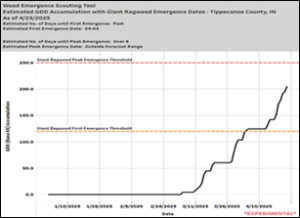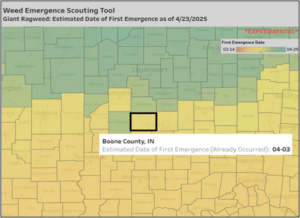Midwestern farmers have faced a buildup of pesticide resistance in pigweeds (waterhemp and Palmer amaranth), highlighting the importance of scouting to detect weeds early in their growth stages. Otherwise, weed escapes are a common issue as herbicides lose their efficacy when weeds are allowed to grow long enough into their growth cycle. The Midwestern Regional Climate Center (MRCC), supported by the USDA National Institute of Food and Agriculture, Crop Protection and Pest Management Program through the North Central IPM Center (2022-70006-38001), has developed the experimental Weed Emergence Scouting Tool (W.E.S.T.) to help farmers estimate when agronomic weeds are likely first to emerge and reach peak emergence based on growing degree day (GDD) models. The tool is currently limited to two weeds: waterhemp and giant ragweed. The MRCC hopes to expand its focus to other weeds with future funding.
The current version allows users to:
- Track GDD (base 48°F) accumulations over the current year (January 1 to the current date) for any Midwest County.
- Based on forecast data, determine whether giant ragweed or water hemp is expected to reach its peak emergence within six days and, if so, in how many days.
- Giant ragweed first emerges at about 120 GDD (base 48°F) and reaches peak emergence between 200 and 300 GDD.
-
- Giant ragweed first emerges at about 120 GDD (base 48°F) and reaches peak emergence between 200 and 300 GDD.
- Waterhemp first emerges at about 425 GDD (base 48°F) and peaks between 500 and 600 GDD.Waterhemp first emerges at about 425 GDD (base 48°F) and peaks between 500 and 600 GDD.Review the current season’s emergence dates for giant ragweed or water hemp in specific Midwest counties.

W.E.S.T. uses high-resolution PRISM temperature data to calculate GDDs with a base of 48°F and adds them to the previous day’s total. Forecast maximum, minimum, and average temperatures from NOAA are adjusted to the county level and are then used to calculate daily GDD accumulations over the subsequent six-day period. Research from Iowa State University indicates that giant ragweed typically emerges with fewer than 150 GDD, while waterhemp requires more than 350 GDD. To refine these estimates, Purdue Extension Educators collected field data across Indiana in 2023. Findings include:
This tool would benefit from your giant ragweed and waterhemp observations to better refine this product. Email mrcc@purdue.edu if you want to provide weed emergence observations to assist in tool validation and refinement
